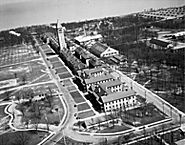| Entries |
| F |
|
Fort Sheridan
|

|
Troops from Fort Sheridan responded only once to labor unrest, in 1894 during the Pullman strikes. In 1898, during the Spanish American War, Fort Sheridan became a mobilization, training, and administrative center and continued to house these functions through World War II, when over 500,000 men and women were processed through military service at the fort. From 1953 to the 1970s, Fort Sheridan fought the Cold War by servicing and supplying all NIKE antimissile systems in the upper Midwest. After 1973 the post again housed administrative and logistical support services. In 1988 Fort Sheridan was among those slated for closure by the Base Realignment and Closure Commission and in 1993 the army post was closed.
After Fort Sheridan was slated for closure, residents of the area formed the Fort Sheridan Joint Planning Commission and developed a reuse plan with public participation. Environmental analysis identified landfills, pesticide storage areas, asbestos-containing material, PCB-containing transformers, unexploded ordnance, and a variety of petroleum products and metals in the soil and groundwater. Environmental cleanup began in 1993. Ninety-four buildings, including 64 designed by Holabird & Roche, are situated on the 110-acre Historic District, designated a National Historic Landmark in 1984. An Army Reserve base continues to use about 90 acres. The remaining property is divided between a golf course and a variety of ongoing commercial and residential developments.
The Encyclopedia of Chicago © 2004 The Newberry Library. All Rights Reserved. Portions are copyrighted by other institutions and individuals. Additional information on copyright and permissions.